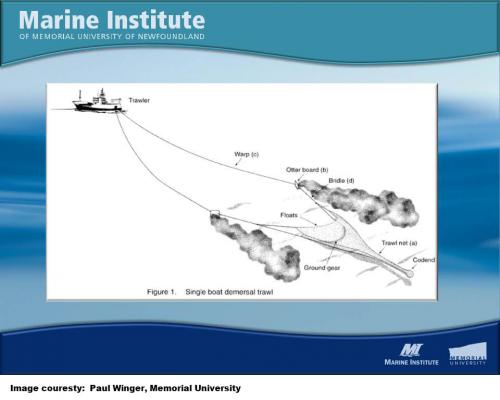Trawl design training workshop looked at factors affecting fish catchability
The latest trawl design workshop in Michigan focused on fish behaviors with trawl equipment present and finds catchability of fish is influenced by several factors.
A trawl design-training workshop was held in early December at the Great Lakes Environmental Research Laboratory in Ann Arbor, Michigan. The Great Lakes Sea Grant Network, Memorial University, and the Great Lakes Environmental Research Laboratory sponsored the workshop.
Great Lakes fishery managers usually do not think about how fish behavior is affected by the presence of a trawl, which could have a direct affect on their fisheries assessment efforts. Research on fish behavior in relation to bottom trawls was reviewed at the workshop. Bottom trawls are one of the most important fishing gears used in  fish stock assessments worldwide including the Great Lakes.
fish stock assessments worldwide including the Great Lakes.
Fish can escape trawl gear in pre-gear zone (ahead of trawl doors), at the mouth of the trawl, and from in the net. Trawls aim to move fish to the center of trawl path, and the challenge with trawls is that it is difficult to assess effective swept area, given the length of the trawl rope. The dominant stimulus ahead of the gear is low frequency noise produced by the vessel and trawl. There can be significant avoidance behavior observed with pelagic fish (fish that live up in the water column), but it is difficult to predict responses.
Bottom fish tend to dive and become more susceptible to bottom trawls up to 600 feet, and catchability is inversely related to depth. Data shows avoidance behaviors occur when vessels are one mile away and individual fish can increase or decrease swimming speed. Otter trawls create sound and noise as the doors dig into sediment and create lift to spread net. Clouds of sediment create a visual threat, so fish trapped within the clouds tend to stay there. As the fish see net, they turn and usually swim with the net until they are exhausted and fall back into the net. For herding to be effective, fish must swim at a speed faster than the trawl. They must also have sufficient endurance to reach the trawl path.
Once in the mouth of trawl, fish have nowhere to go and they typically orient with the trawl and move at the speed of trawl. The time until capture depends on how long each species swims with the trawl before tiring. There is a wide range of endurance (seconds up to 15 minutes) depending on trawl speed. As the fish become exhausted, most fall back into the trawl but some escape over the headline or under the headgear. Inside the net, fish can escape from the cod end, or anywhere in the net, depending on fish and mesh sizes.
 Catchability changes due to the vulnerability and availability of fish. A number of factors might cause variation in these parameters including temperature, light intensity, current, towing speed, fish density, weather, lack of standardized operating procedures and gear specifications. Temperature is believed to be a key factor because it affects fish behavior in so many ways. Both the likelihood of a reaction and reaction distance to the trawl would be lower in winter, which means trawls can get closer before there is an observed behavioral response. Some research demonstrates that temperature affects behavior in the sweep zone. Fish have a greater chance of being herded at higher temperatures, meaning in winter they will have a greater chance of escape because they will not be herded far enough to reach the trawl path.
Catchability changes due to the vulnerability and availability of fish. A number of factors might cause variation in these parameters including temperature, light intensity, current, towing speed, fish density, weather, lack of standardized operating procedures and gear specifications. Temperature is believed to be a key factor because it affects fish behavior in so many ways. Both the likelihood of a reaction and reaction distance to the trawl would be lower in winter, which means trawls can get closer before there is an observed behavioral response. Some research demonstrates that temperature affects behavior in the sweep zone. Fish have a greater chance of being herded at higher temperatures, meaning in winter they will have a greater chance of escape because they will not be herded far enough to reach the trawl path.
At the trawl mouth, temperature should affect length of time fish could swim along with trawl. In cold water, maximum swimming speed and endurance decrease, leading to an overestimate of population abundance. Another key factor is likely light intensity, as there are reduced responses at lower light levels. At the trawl mouth, fishes vulnerability to capture increases greatly at night. Bottom current is another important factor as currents can affect how a net fishes. Side currents move around zones of vulnerability and can change escapement. Finally, any subtle changes in speed of the trawl can influence vulnerability. There is a need to standardize surveys to generate consistent indices.
At the workshop, there were suggestions that more research occur when changing to a different trawl with concerns about how the trawl data is currently used. It is used to make comparisons across lakes, habitats, depths, etc., but a determination on how catchability changes over different conditions is still needed.



 Print
Print Email
Email


